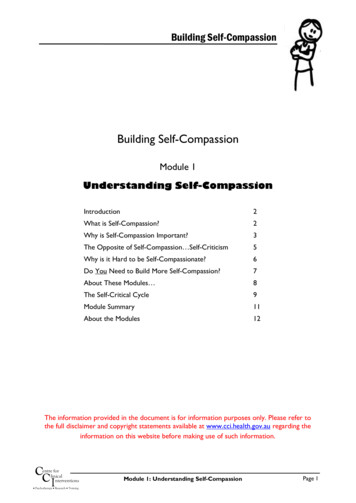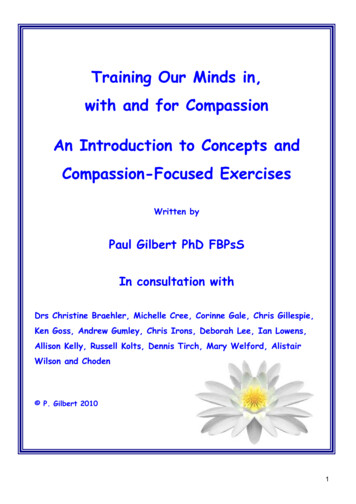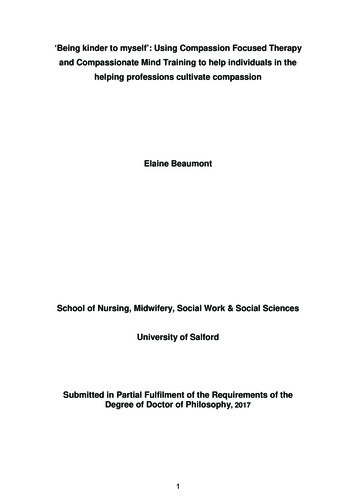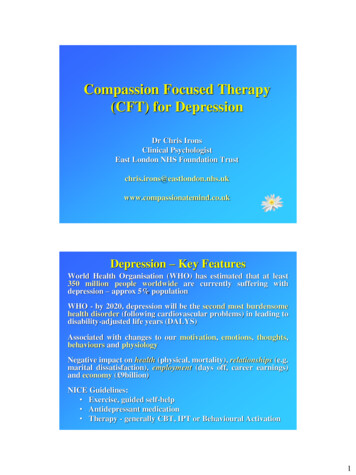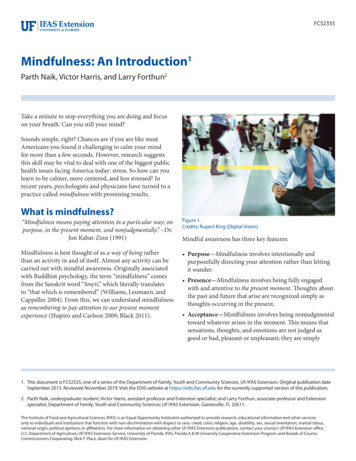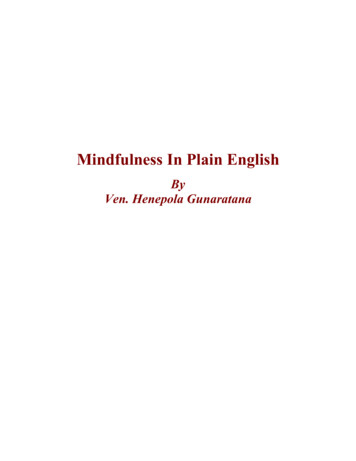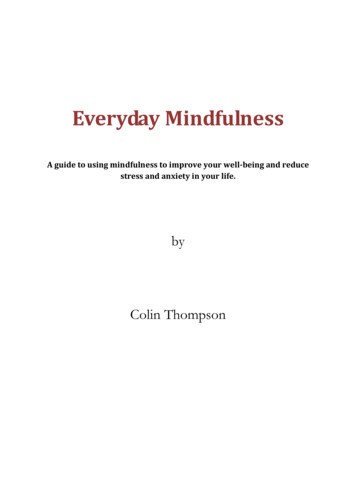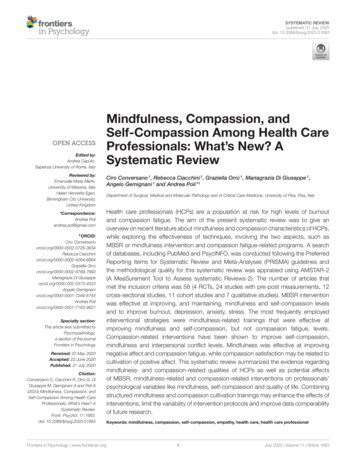
Transcription
SYSTEMATIC REVIEWpublished: 31 July 2020doi: 10.3389/fpsyg.2020.01683Edited by:Andrea Caputo,Sapienza University of Rome, ItalyReviewed by:Emanuele Maria Merlo,University of Messina, ItalyHelen Henrietta Egan,Birmingham City University,United Kingdom*Correspondence:Andrea Poliandrea.poli@gmail.com† ORCID:Ciro Conversanoorcid.org/0000-0002-0726-3634Rebecca Ciacchiniorcid.org/0000-0002-4264-6884Graziella Orrùorcid.org/0000-0002-8769-7693Mariagrazia Di Giuseppeorcid.org/0000-002-0373-4523Angelo Gemignaniorcid.org/0000-0001-7249-874XAndrea Poliorcid.org/0000-0001-7163-9627Specialty section:This article was submitted toPsychopathology,a section of the journalFrontiers in PsychologyReceived: 22 May 2020Accepted: 22 June 2020Published: 31 July 2020Citation:Conversano C, Ciacchini R, Orrù G, DiGiuseppe M, Gemignani A and Poli A(2020) Mindfulness, Compassion, andSelf-Compassion Among Health CareProfessionals: What’s New? ASystematic Review.Front. Psychol. 11:1683.doi: 10.3389/fpsyg.2020.01683Frontiers in Psychology www.frontiersin.orgMindfulness, Compassion, andSelf-Compassion Among Health CareProfessionals: What’s New? ASystematic ReviewCiro Conversano † , Rebecca Ciacchini † , Graziella Orrù † , Mariagrazia Di Giuseppe † ,Angelo Gemignani † and Andrea Poli*†Department of Surgical, Medical and Molecular Pathology and of Critical Care Medicine, University of Pisa, Pisa, ItalyHealth care professionals (HCPs) are a population at risk for high levels of burnoutand compassion fatigue. The aim of the present systematic review was to give anoverview on recent literature about mindfulness and compassion characteristics of HCPs,while exploring the effectiveness of techniques, involving the two aspects, such asMBSR or mindfulness intervention and compassion fatigue-related programs. A searchof databases, including PubMed and PsycINFO, was conducted following the PreferredReporting Items for Systematic Review and Meta-Analyses (PRISMA) guidelines andthe methodological quality for this systematic review was appraised using AMSTAR-2(A MeaSurement Tool to Assess systematic Reviews-2). The number of articles thatmet the inclusion criteria was 58 (4 RCTs, 24 studies with pre-post measurements, 12cross-sectional studies, 11 cohort studies and 7 qualitative studies). MBSR interventionwas effective at improving, and maintaining, mindfulness and self-compassion levelsand to improve burnout, depression, anxiety, stress. The most frequently employedinterventional strategies were mindfulness-related trainings that were effective atimproving mindfulness and self-compassion, but not compassion fatigue, levels.Compassion-related interventions have been shown to improve self-compassion,mindfulness and interpersonal conflict levels. Mindfulness was effective at improvingnegative affect and compassion fatigue, while compassion satisfaction may be related tocultivation of positive affect. This systematic review summarized the evidence regardingmindfulness- and compassion-related qualities of HCPs as well as potential effectsof MBSR, mindfulness-related and compassion-related interventions on professionals’psychological variables like mindfulness, self-compassion and quality of life. Combiningstructured mindfulness and compassion cultivation trainings may enhance the effects ofinterventions, limit the variability of intervention protocols and improve data comparabilityof future research.Keywords: mindfulness, compassion, self-compassion, empathy, health care, health care professional1July 2020 Volume 11 Article 1683
Conversano et al.Mindfulness and Self-Compassion in Health ProfessionalsINTRODUCTIONelicited by practice and positive regulation of the immunesystem activity, may be conceptualized as the outcome ofbrain modification through mindfulness. Furthermore, a recentreview highlights how meditation can elicit a meta-functioningof awareness in those who practice, allowing an increasedmind/body regulation system (Giannandrea et al., 2019).In particular, mindfulness training seems to increase threequalities of attention: (1) Attentional stability, meant to focussustained attention without wandering. It is estimated that thehuman mind gets distracted for about half of the waking hours;mindfulness, both state and trait, is associated with a reductionin mental digressions, bringing the person back to focus onthe present (Killingsworth and Gilbert, 2010; Smallwood andSchooler, 2015); (2) voluntary control of attention or selectiveattention, the ability to direct attention to a specific topicrather than another in an appropriate and voluntary manner(Wadlinger and Isaacowitz, 2011); (3) efficiency of attention,or an economic use of cognitive resources, involving lessexpenditure of cognitive activities for an attention performanceon a specific task. Since mindfulness is based on the abilityto control and orientate attention, it was also associatedwith an improvement in efficiency (Cahn and Polich, 2009).Regarding neural networks (Menon and Uddin, 2010; Menon,2011; Piccinni et al., 2012), several studies are investigating theeffects of mindfulness on the default mode network (DMN),the neural processes underlying spontaneous thoughts andwandering mind. In psychopathology, the DMN is often foundto be hyperactivated and hyperconnected (Whitfield-Gabrieliand Ford, 2012). Research investigating expert mindfulnessmeditators engaging in simple breathing practice showed thatactivity in brain regions associated with the DMN was presentduring mind wandering, and in salience network (SN) areasduring awareness of mind wandering, while regions of theexecutive network were active during shifting and sustainedattention (Hasenkamp et al., 2012; Scheibner et al., 2017;Orrù et al., 2020a,b), and the effects were modulated bylifetime meditation experience (Brewer et al., 2011; Hasenkampand Barsalou, 2012). Furthermore, research has shown thatmindfulness training can lead to changes in the SN that regulatesthe switching between DMN and central executive network.Following mindfulness meditation, but not relaxation training,central regions of the SN, the left anterior cingulate cortex(ACC) and insula, showed improved cerebral blood flow (Tanget al., 2015). Similarly, loving-kindness meditators showed adeactivation of main nodes of the DMN (Brewer et al., 2011)and, after few weeks of compassion training, novice meditatorsshowed significant reductions of mind wandering (Jazaieri et al.,2014). Taken together, these results suggest that though the focusof compassion meditation does not involve regulating attentionalprocesses on a specific object, compassion training does have animpact on attentional processes involved in DMN.Mental training following a mindfulness-based programseems to increase cognitive abilities both as cognitive capacityand as cognitive flexibility. The first includes working memoryand fluid intelligence, the second supports the adaptation ofan individual using new answers and strategies. Mindfulnesstraining is associated with an increased working memoryMindfulness has been defined as the awareness that arisesby intentionally paying attention, in the present moment andin a non-judgmental way, to the flow of experience (KabatZinn, 2003). Mindfulness is a theoretical instance that finds itsimplementation in a set of meditation and psycho educationalexercises aimed at understanding certain fundamental themessuch as stress, attachment and dependence on internal andexternal content and therefore the importance of subjectiveobservation of thoughts, emotions, and physical sensations(Kabat-Zinn, 2009; Rosa et al., 2019). Mindfulness propensity isknown as facilitators of well-being and adaptation for healthcareprofessionals, together with high adaptive defense mechanisms(Catalano et al., 2019; Di Giuseppe et al., 2019a, 2020a,c; Martinoet al., 2020a). Moreover, mindfulness interventions proved to bevery helpful in reducing the psychopathological symptomatologyof chronic conditions (Bonadonna, 2003; Catalano et al., 2017;Poli et al., 2017, 2019; Conversano and Marchi, 2018; Marchiniet al., 2018; Conversano, 2019; Di Giuseppe et al., 2019b, 2020b;Martino et al., 2019a,b, 2020b; Merlo, 2019; Conversano et al.,2020a; Lenzo et al., 2020; Poli et al., 2020).The most widespread protocol used both in the clinical and inthe normal context is represented by a group-based interventionnamed Mindfulness-Based Stress Reduction (MBSR). It is aprotocol characterized by the teaching of formal and informalmeditation practices, yoga exercises and the sharing of groupexperiences (Kabat-Zinn, 2009). The aim of MBSR is toimprove mindfulness ability in participants, helping them tointegrate their mind and body activity in a non-judgmental way.Starting from the MBSR program, in the following years, manyprotocols based on it have been developed for research purposes,integrating various aspects of psychological and behavioralsciences (Shonin et al., 2013).A plethora of research show that mindfulness-basedinterventions (MBIs) determine significant benefits both inclinical and non-clinical samples. On the one hand, MBIswould seem to increase awareness levels, strategies to cope withstressful situations and emotion management; on the otherhand, they seem to reduce levels of perceived stress, anxiety, anddepressive symptoms (Brown and Ryan, 2003; Cahn and Polich,2006; Chiesa and Serretti, 2011). Generally, MBIs have showna significant correlation with positive improvements in thefollowing areas: attention, cognition, behavior and physiologicalprocesses which probably influence the functioning of theindividual and their quality of life (Veltri et al., 2012; Jha et al.,2019; Marchi et al., 2019; Marazziti et al., 2020).Tang et al. (2018), in their review, have emphasized howmindfulness acts mainly on three systems, such as attentionalcontrol, emotional regulation and self-awareness. The authorsalso highlighted that mindfulness practice can produce changesin both density and volume in gray matter, finding thefollowing areas involved in mindfulness meditation: variousprefrontal regions, anterior cingulate cortex, medial prefrontalcortex, striatum, amygdala, insula, posterior cingulate cortexand precuneus. Furthermore, the central effect that mindfulnesspractice plays on stress axes, together with plastic brain aspectsFrontiers in Psychology www.frontiersin.org2July 2020 Volume 11 Article 1683
Conversano et al.Mindfulness and Self-Compassion in Health Professionalsawareness) involves noticing what is most salient and alive inyour field of awareness, moment-to-moment; loving-kindnessmeditation entails intentionally cultivating happiness whilecompassion meditation is about cultivating goodwill in theface of suffering (Germer and Siegel, 2014). While attentionalmeditation practices (focused attention and open monitoring)require focusing on a focal object or on a component partof the self, like perception, emotion, cognition or intention,loving-kindness, and compassion meditation require the self asthe object of practice (Olendzki, 2013; Germer and Siegel, 2014;Dahl et al., 2015).In particular, compassion is defined by Paul Gilbert, andthe Buddhist monk Choden, as a sensitivity to suffering in selfand others with a commitment to try to alleviate and preventit (Gilbert, 2018), while self-compassion is defined by KristinNeff as “being open to and moved by one’s own suffering,experiencing feelings of caring and kindness toward oneself,taking an understanding, non-judgmental attitude toward one’sinadequacies and failures, and recognizing that one’s experienceis part of the common human experience” (Neff, 2003). Recentbrain imaging research supports the notion of evaluatingcompassion as more emotionally engaging than mindfulness.Compassion practice was found to activate regions of the positiveaffect system, such as the medial orbitofrontal cortex, nucleusaccumbens and the ventral striatum (Klimecki et al., 2013,2014; Engen and Singer, 2015). Specifically, Engen and Singer(2015) compared compassion meditation in response to cognitivereappraisal and showed that, in response to empathic distress,compassion meditation activated brain systems associated topositive emotion, while cognitive reappraisal recruited cognitivecontrol regions and reduced activation of the negative affectsystem regions. Research also pointed out that mindfulnesspractitioners show reduced activation and structural changesof the amygdala (Hölzel et al., 2013; Taren et al., 2013,2015). Overall, these results suggest that beneficial effects ofmindfulness and compassion practices may act through differentmechanisms: mindfulness reduces negative affect system’sactivity while compassion increases activity of positive emotionbrain systems.Interestingly, it has been shown that transcutaneous vagusnerve stimulation is able to modulate DMN in major depressivedisorder (Fang et al., 2016) and that increased vagal activitywas associated with higher compassion levels (Stellar et al.,2015). It has been shown that adopting a true compassionatedisposition when viewing pictures of people suffering activatedthe mesolimbic dopamine pathway (ventral tegmental area andthe ventral striatum) implicated in reward and bond formation(Kim et al., 2009). More recently, research showed that the septalnuclei, another area that is relevant for reward and prosocialmotivation, was the unique region that was typically activatedacross empathy for pain, anxiety and happiness. Septal activationin course of these empathic experiences was predictive ofhelping (Morelli et al., 2014). Remarkably, it was recently shownthat optogenetic activation of gut-innervating vagal sensoryneurons, namely the dorsolateral parabrachial-nigral projections,mimicked the rewarding effects of right vagus excitation andidentifies dorsolateral parabrachial region as the mandatorycapacity, cognitive flexibility and benefits on fluid intelligence(Roeser et al., 2013; Ruocco and Direkoglu, 2013; Jha et al., 2
exercises aimed at understanding certain fundamental themes such as stress, attachment and dependence on internal and external content and therefore the importance of subjective observation of thoughts, emotions, and physical sensations (Kabat-Zinn, 2009; Rosa et al., 2019). Mindfulness propensity is known as facilitators of well-being and adaptation for healthcare professionals, together
